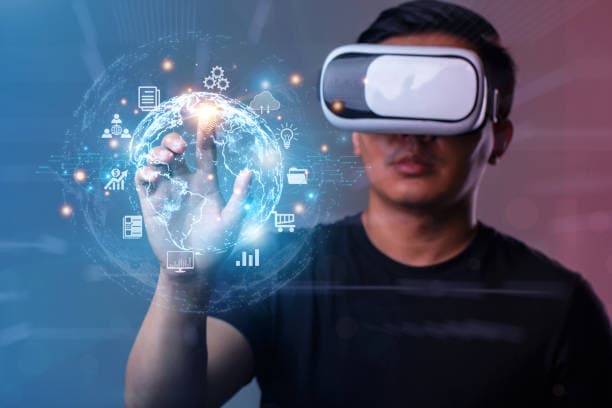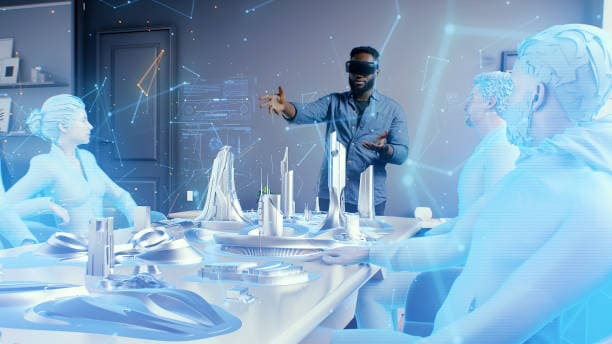Virtual reality (VR) is an artificially created world that imitates the real one. The latest technical tools allow to create unique effects projected on the user’s mind, making it possible to experience close to real feelings. Thanks to this, VR has gained immense popularity in the modern world.
Today, VR technologies are developing rapidly and are used in various projects. They cover numerous areas and industries, such as
- Video games
- Education
- Industry
- Medicine
- Film industry
The gaming market always follows the trends, so it is not surprising that virtual reality technology has become very popular in this industry.
Using VR headsets to immerse yourself in the virtual world
To immerse yourself in an artificially created world, special glasses or a helmet are most often used. The headset is worn on the head and has a simple principle of operation: there is a display in front of the user’s eyes, which displays the necessary video. An accelerometer and a gyroscope are attached to the body, which track head movements and transmit information to the app. Based on the sensor readings, the image on the display changes. According to the recommendations of experts from Legjobbkaszino, the use of high-quality equipment significantly improves the experience of interacting with virtual reality.
Thus, a person gets the opportunity to look around inside the virtual world. Today, plastic lenses are actively used to make the picture clearer and focus it. Various tracking systems can also be used for the most realistic immersion:
- Motion tracking. It tracks user movements and reproduces them in a virtual environment using a video camera or sensors.
- Eye tracking systems. They monitor pupil movements to determine where the user is looking. They are usually used in scientific and medical fields.
- 3D controllers. Instead of simple joysticks, multifunctional controllers are used to work effectively in the virtual world.
- Devices with feedback. They are used for the most realistic sensations, for example, rotating chairs or vibrating joysticks.
Previously, computers or game consoles were used to create 3D images. Today, however, headsets that work perfectly with modern mobile phones are popular, which has reduced the cost of equipment.
Innovative Applications of VR
Field of application
Virtual reality technology is rapidly gaining popularity, and new equipment is entering the commercial market. VR has a great potential that has found application in both entertainment and other industries. Here are some interesting and effective ways to use this technology:
Manufacturing
One of the most interesting developments is CAVE. This is an automatic virtual environment where three-dimensional screens are installed in a special room with flat walls. A person puts on glasses and studies objects from different angles. This technology is actively used in car manufacturing. For example, Ford overlays virtual models on physical ones, which saves money and allows it to quickly find and eliminate design errors.
Advertising
VR can radically change advertising campaigns, making them more useful and interesting. Google has created simple Cardboard VR glasses that work with a mobile phone. This affordable and easy-to-use solution allows anyone to view VR content. Furthermore, brands can create immersive experiences that engage consumers on a deeper level. For instance, virtual reality can be used to create interactive product demonstrations, virtual store tours, and engaging storytelling that captures the audience’s attention more effectively than traditional advertisements. This innovative approach can significantly enhance customer engagement and brand loyalty.

New life for old rides
Theme parks in Canada have started to implement VR technologies to breathe new life into old attractions. The use of VR headsets allows synchronising images with real movements on slides, which creates a unique and realistic experience for visitors. According to promo kod casino, such innovations attract even more visitors. Additionally, VR can be used to update and re-theme rides with minimal physical changes, offering new and exciting adventures without the need for extensive renovations. This technology also provides opportunities for seasonal or temporary experiences, keeping the attractions fresh and encouraging repeat visits from guests.
Surgical simulation
The Montreal Neurological Institute uses the NeuroTouch Cranio simulator to train neurosurgeons. The system helps students to improve their skills without risking patients by analysing the operations performed and giving individual recommendations. Furthermore, VR-based surgical simulations can recreate complex and rare surgical scenarios, providing invaluable hands-on experience that is difficult to achieve through traditional training methods. These simulations also allow for repeated practice and immediate feedback, which are crucial for mastering delicate surgical techniques. As a result, VR technology contributes to higher proficiency and confidence among future surgeons, ultimately enhancing patient safety and care.
Virtual reality continues to evolve and finds new applications, making people’s lives more interesting and convenient. As technology advances, VR is likely to become even more integrated into our daily routines, transforming various industries and enhancing user experiences. The future of VR holds immense potential, promising innovations that will further bridge the gap between the real and virtual worlds.


